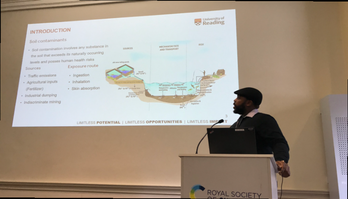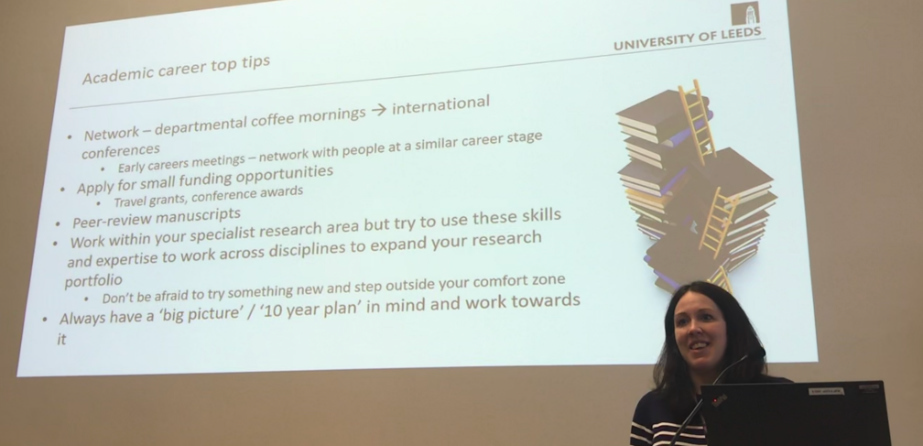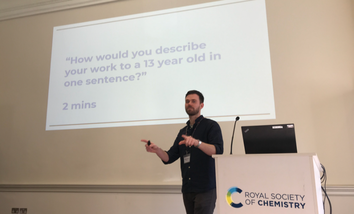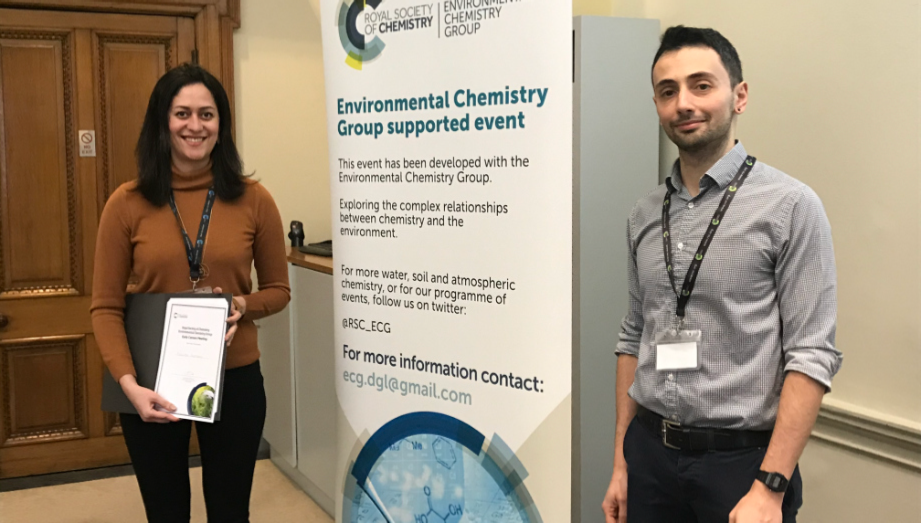Environmental Chemistry of Water, Sediment, Soil and Air: Early career researchers' meeting
On Wednesday 11th March, 24 early career researchers gathered at the RSC’s venue in Burlington House, London, for what was the first, and probably last, in-person scientific meeting organised by the Environmental Chemistry Group in 2020. The day proceeded with 8 oral presentations (including two keynote lectures) separated by coffee and lunch breaks that provided an opportunity for delegates to discuss research findings showcased in 7 poster presentations.
The day started with a talk from MD Hanif (Imperial College, London), who presented research findings from the use of geochemical surface complexation models (D&M and CD-MUSIC) to simulate the competitive adsorption of Zn on ferrihydrite and goethite in saline Bangladeshi groundwater.
The day started with a talk from MD Hanif (Imperial College, London), who presented research findings from the use of geochemical surface complexation models (D&M and CD-MUSIC) to simulate the competitive adsorption of Zn on ferrihydrite and goethite in saline Bangladeshi groundwater.
This was followed by a presentation by AM Amira (Hassan II University of Casablanca, Morocco) on the use of dolomitic (CaMg(CO3)2) rocks from the Khenifra region of Morocco as adsorbents for cationic and anionic dyes (methylene blue and Congo red) from wastewater. Batch sorption reactions revealed very high and very fast removal of methylene blue, which followed 2nd order kinetics. This indicated chemical sorption, which increased with increasing temperature, mass of sorbate, and pH. The dolomitic rocks showed a high potential as low-cost adsorbents in wastewater treatment plants.
|
The next talk was given by Chinonso Ogbaugu (University of Reading), who presented experimental data on the construction of Langmuir isotherms for the adsorption of lead on biochars made from a variety of different source materials. A relationship between the C/N ratio of the biochar feedstock and the Langmuir sorption capacity was demonstrated, which indicates that feedstocks for making biochar with optimal sorption capacities could be selected based on C/N ratio without prior experimentation. Mr Ogbaugu was awarded the prize for the best oral presentation (Figure 1).
|
Before lunch, Dr Laura Carter (University of Leeds) delivered a keynote lecture that took the audience on a journey through her career path from her PhD at the University of York to a job in industry at Unilever, Postdocs in Adelaide and York, and finally her appointment as an Academic Fellow at the University of Leeds. In her recent article in the RSC journal Environmental Science: Processes and Impacts (1), for which she was recognised as an Emerging Investigator, Dr Carter highlighted that there is currently not enough data to generate thresholds for safe levels of pharmaceuticals in the environment. Her research to date has focused on how the physiochemical properties of pharmaceuticals, the soil type, and the environmental conditions affect their uptake and sub-lethal impact on plants. Dr Carter provided on-point and practical advice for early career scientists interested in an academic career (Figure 2). Her future work will focus on scaling up her research to help understand how pharmaceuticals may impact pollinators within the landscape. After lunch, Antony Poveda (Mangorolla CIC) provided an exciting introduction to ‘I’m a Scientist, Get me out of here!’, an online public engagement programme that pairs scientists with school children. Mr Poveda started by challenging us to compose one sentence to describe our research to a 13 year old (Figure 3), illustrative of the tasks he uses to select participating scientists.
Mr Poveda explained that approximately 48% of the UK population live more than a 30 minute drive from a research-intensive institution, and schools that are more than 30 minute drive away are likely to receive half as many visits from a scientist (https://imascientist.org.uk/distance). ‘I’m a Scientist, Get me out of here!’ therefore provides a valuable service to children who may have no other contact with scientists by raising their science capital and increasing the likelihood that they might go on to become a scientist or an engineer.
The scientific programme continued after a well-earned caffeine and poster break with a presentation from Elmustapha Ennesyry (Hassan II University of Casablanca, Morocco) on the development of a low-cost and non-hazardous catalyst using Moroccan oil shale for the green synthesis of hydroxyphosphonates for use as plant protection products. He was able to demonstrate regeneration and re-use of the catalyst up to 4 times with a 70% yield.
Christopher Wallis (Polymateria Limited) then provided an engaging introduction to the soil ecotoxicology tests he has carried out on additives to plastic products that have been designed to facilitate the complete biodegradation of the plastic in the environment. Tests conducted following OECD guidelines reveal that the additives that allow shrink wrap to degrade to less than 90% of the original mass in 266 days are not toxic to earthworms, plants, or water fleas.
The final talk of the day was given by Nina Schleicher (Imperial College, London), who presented her research on the mercury concentrations in particulate matter in Beijing. She used data collected during the 2008 Olympic Games as a large-scale field experiment since several factories and power stations were shut down and vehicle use restricted during the two week period while the games took place. Her data indicated that the primary source of particulate mercury in Beijing air was from coal combustion. She also revealed that there was more mercury present in the smallest particles that are known to be more associated with human health impacts.
The scientific programme continued after a well-earned caffeine and poster break with a presentation from Elmustapha Ennesyry (Hassan II University of Casablanca, Morocco) on the development of a low-cost and non-hazardous catalyst using Moroccan oil shale for the green synthesis of hydroxyphosphonates for use as plant protection products. He was able to demonstrate regeneration and re-use of the catalyst up to 4 times with a 70% yield.
Christopher Wallis (Polymateria Limited) then provided an engaging introduction to the soil ecotoxicology tests he has carried out on additives to plastic products that have been designed to facilitate the complete biodegradation of the plastic in the environment. Tests conducted following OECD guidelines reveal that the additives that allow shrink wrap to degrade to less than 90% of the original mass in 266 days are not toxic to earthworms, plants, or water fleas.
The final talk of the day was given by Nina Schleicher (Imperial College, London), who presented her research on the mercury concentrations in particulate matter in Beijing. She used data collected during the 2008 Olympic Games as a large-scale field experiment since several factories and power stations were shut down and vehicle use restricted during the two week period while the games took place. Her data indicated that the primary source of particulate mercury in Beijing air was from coal combustion. She also revealed that there was more mercury present in the smallest particles that are known to be more associated with human health impacts.
|
During the lunch and afternoon coffee breaks, posters were displayed by delegates on topics ranging from VOC emissions from personal care products to carbon sequestration in the alkaline waste materials of steel slag, and the synthesis of bionanocomposites for use as photocatalysts for the degradation of organic dyes. The prize for the best poster presentation was awarded to Fereshteh Hojatisaeidi (London South Bank University) for her work on the modification of porous boron nitride with nickel to increase its capacity to adsorb carbon dioxide as a novel low cost carbon capture technology with high thermal and oxidation resistance (Figure 4).
|
References
- Carter, L.J., Chefetz, B., Abdeen, Z. and Boxall, A.B., Environmental Science: Processes & Impacts, 21, 605-622, (2019).





